Gutter Cleaning: Why, How Often, and With What?
Every homeowner knows the drill: autumn winds blow, leaves fall – and suddenly, gutters are clogged. Clearing them out to ensure optimal water flow sounds like a tedious chore you'd rather put off, doesn't it? Yet, with the right preparation and tools, cleaning your gutters is a straightforward task you can handle yourself – without the hassle or expense of hiring professionals.
In this blog post, we guide you step-by-step through cleaning your gutters properly, highlighting what to watch out for, which accessories make the job easier, and why it's crucial to regularly clear the downspout as well. With a few helpful tips, you will quickly find out: this task isn’t as complicated as it seems!
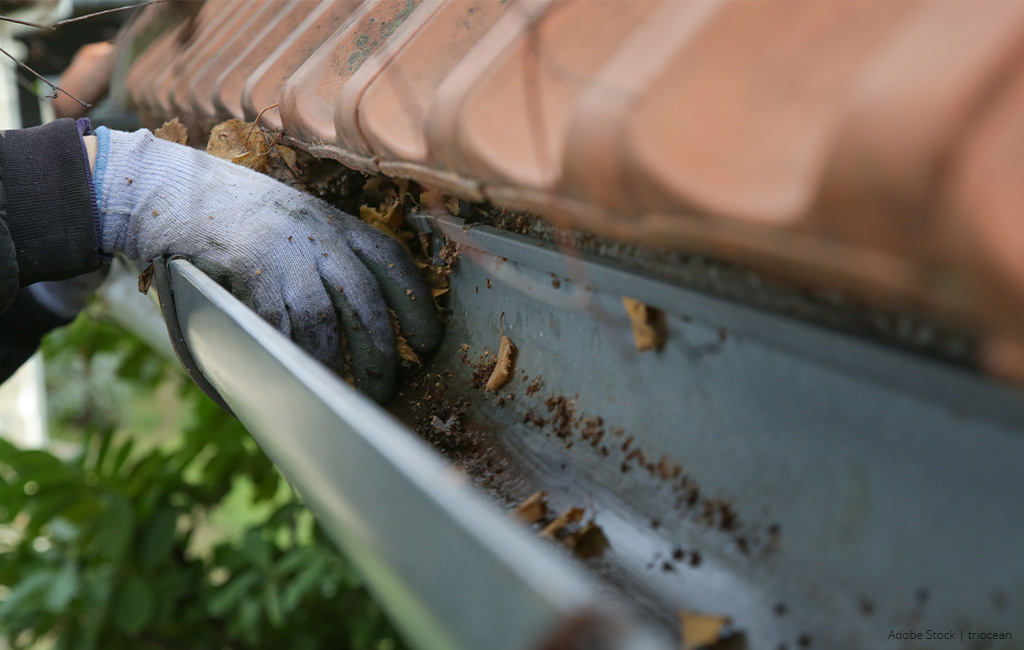
Gutter Cleaning: Why Is It So Important?
A clean gutter is essential to protect your home from costly damage. When leaves, moss, dirt, and other debris clog the gutter, rainwater can no longer flow properly. Excess water then finds alternative paths – often along the facade or into the building structure. This can lead to damage to exterior walls, the foundation, or even cause moisture issues in the basement.
Why Gutters and Downspouts Must Stay Clean
- Prevention of Water Damage: Clogged gutters fail to channel rainwater away, leading to overflows and potential water damage to the facade.
- Protection Against Mould Growth: When water can't drain, it accumulates. This damp environment promotes mould growth, especially near walls and roofs.
- Extended Roof Lifespan: Overflowing water can impact rafters and other parts of the roof structure, potentially causing long-term damage.
How Often and When Should You Clean Your Gutter?
Regular cleaning ensures that your gutter and downspout remain clog-free and function optimally. It’s generally recommended to clean gutters at least twice a year: once in autumn after the leaves have fallen, and again in spring to remove winter debris and dirt. If your home is near trees, more frequent cleaning may be necessary, as leaves and branches can accumulate more quickly. Additionally, after heavy rainfall or storms, large amounts of leaves and branches may find their way into the gutter, making an extra cleaning advisable.
Good to Know: Who Is Responsible for a Clean Gutter?
In Switzerland, gutter cleaning is generally the landlord's responsibility, as it is part of the building's maintenance obligations (Art. 256 of the Swiss Code of Obligations, OR). This means the landlord must ensure the gutters are kept clear to protect the property from water damage.
However, the costs for professional cleaning can be passed on to tenants as ancillary charges, provided this is explicitly stated in the rental agreement (Art. 257a OR). If such an agreement exists, you won't need to climb the ladder yourself but will cover the cleaning service costs through your ancillary charges. Without such a provision in the rental contract, the landlord remains responsible for the expenses.
Who Is Liable and Pays for Damage Caused by Clogged Downspouts?
If damage occurs due to a clogged gutter, the party responsible for cleaning, as specified in the contract, is liable. If the cleaning duty has been assigned to you as the tenant, you may be held accountable. However, if no specific agreement was made, liability remains with the landlord, who is then also responsible for addressing any resulting damage.
Gutter Cleaning: Guide and Tips
With our step-by-step guide, cleaning your gutter becomes a simple and efficient task. We’ll show you how to keep your gutter clean and ensure reliable rainwater flow using the right techniques and tools. This way, you can prevent unnecessary damage and keep your roof and home well protected.
Preparations and Safety Measures
Before starting your gutter cleaning, it’s worthwhile to take a few basic safety precautions. After all, it’s not just about clean gutters but also about your safety. Working at height makes gutter maintenance potentially risky. However, with a stable ladder – ideally with a holding device – and the right tools, you can work safely and comfortably.
Using Devices with Telescopic Extensions
Gutters positioned at heights of 3.5 to 4 metres can be easily reached from the ground with a suitable device equipped with a telescopic extension, such as the Einhell leaf blower with gutter kit. This tool facilitates cleaning by allowing you to maintain a secure footing from ground level.
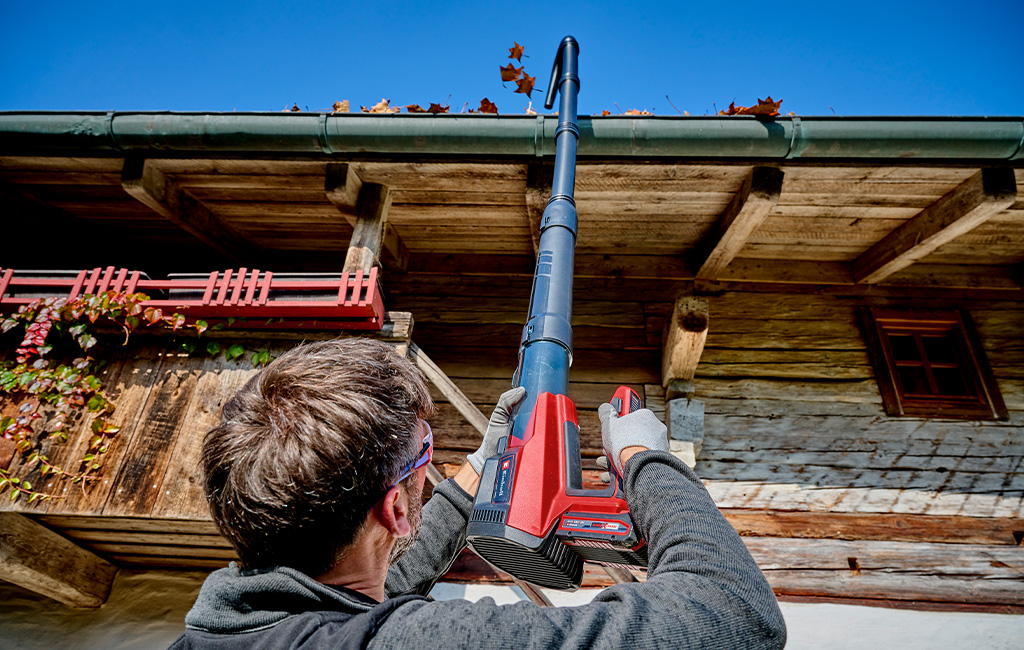
For higher gutters, as found on multi-storey houses or large apartment buildings, a telescopic extension is often insufficient. In these cases, a stable ladder is essential. For particularly tall buildings, using a lift or hiring a professional cleaning service may be necessary to ensure safe and thorough gutter cleaning.
What to Keep in Mind:
- Stable Ground Surface: Place the ladder on a solid, non-slip surface and ensure it stands securely. Having a second person to steady the ladder enhances safety further.
- Wait for Suitable Weather: Wet or windy weather can make cleaning unsafe. Dry, calm days are ideal, as the gutter is less slippery, and you have a more secure footing.
- Protective Gear: Gloves protect you from sharp edges and dirt, while safety goggles keep dust and small particles away. Additionally, wear non-slip shoes when working on the ladder.
Gutter Cleaning by Hand or with Suitable Tools
You can clean your gutter the traditional way by hand or with practical technical assistance. Here, we will show you which method is best for each situation and how to proceed effectively.
Extra Tip: Seal the Downspout
Before you begin cleaning, close off the gutter’s entry to the downspout. This prevents dirt, leaves, or moss from accidentally entering and clogging the downspout.
Manual Cleaning: Simple and Effective
The classic method of cleaning by hand is particularly suitable when there’s only a small amount of easily removable debris. Here’s what you’ll need:
- Stable Ladder: Place it on a solid surface and ensure it has a holding device.
- Bucket and Gloves: For direct disposal of debris and to protect your hands.
- Brush or Hand Broom: For stubborn buildup like moss or encrusted dirt.
Work your way from one end to the other, disposing of debris directly into the bucket. This keeps the gutter clear, allowing water to flow smoothly again.
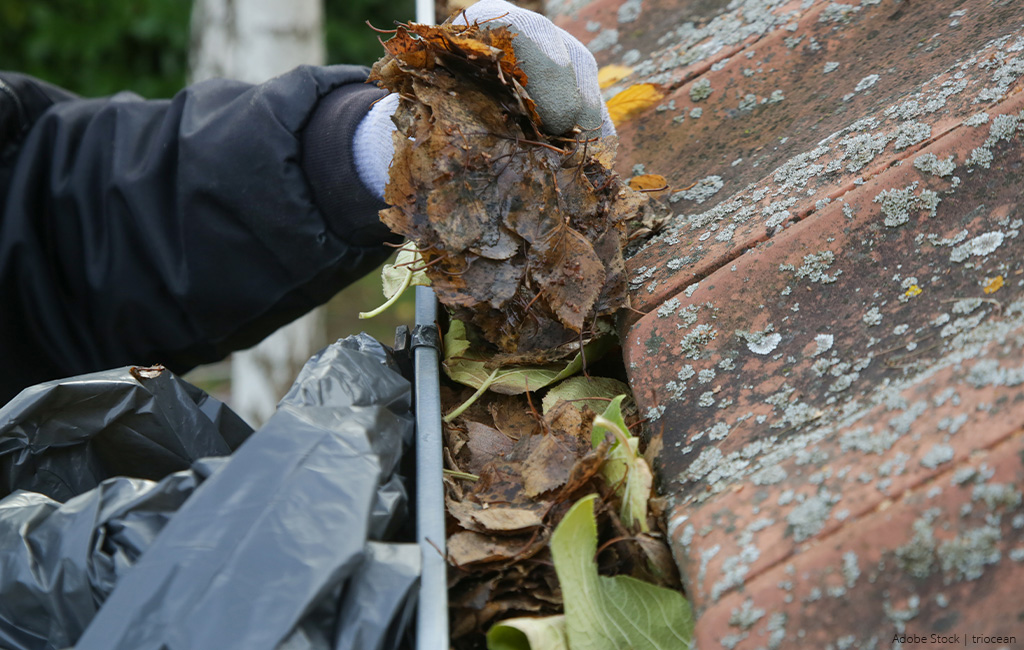
Cleaning with Technical Assistance
If you want to make the job easier or your gutter is heavily soiled, several practical tools can assist you:
- Leaf Blower with Gutter Kit: Using a leaf blower with an extended nozzle, you can blow dirt and leaves out of the gutter from ground level – ideal for gutters up to 4 metres high.
- Cordless Pressure Washer HYPRESSO: When working on a ladder, the Einhell cordless pressure washer HYPRESSO with medium pressure (24 bar) provides gentle, precise cleaning. It draws water via a hose directly from a bucket or, when connected to a tap, even from a PET bottle.
- High Pressure Cleaner with Angled Nozzle: For thorough cleaning, use a high pressure cleaner with a hose and angled nozzle. Ensure the pressure washer is stable on the ground, and that the hose is long enough to reach the gutter.
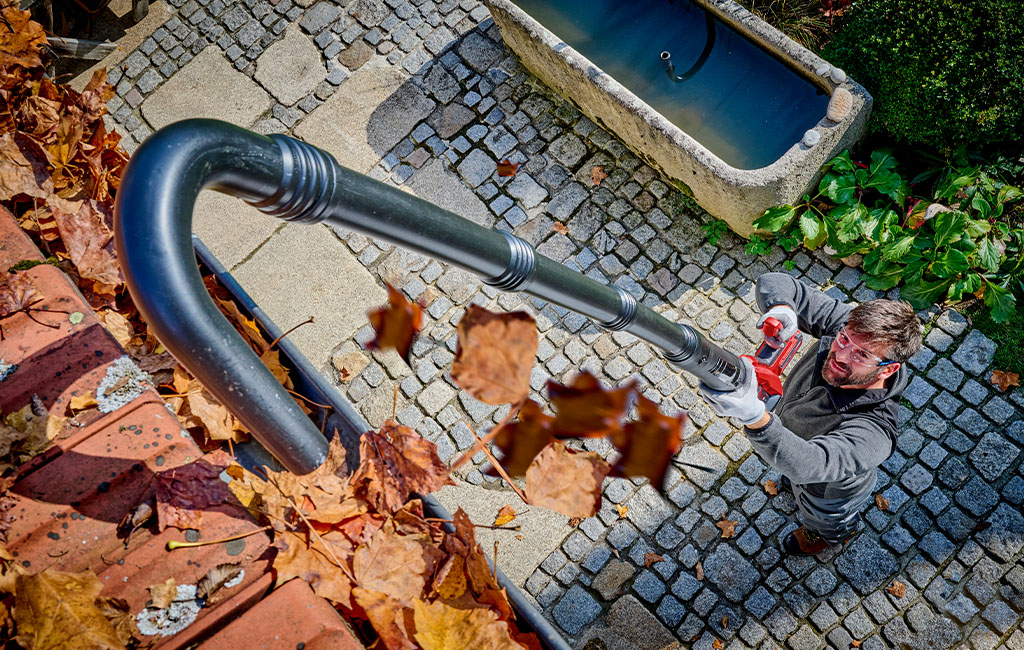
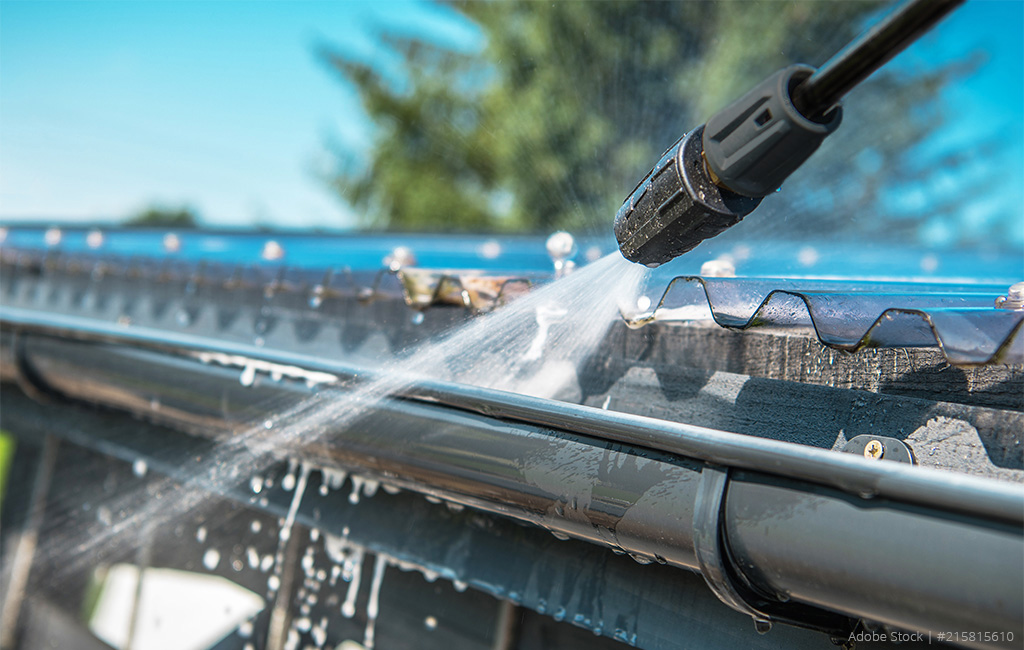
After Cleaning: Function Test
Finally, test to ensure that water can flow freely again. Simply run water into the gutter with a garden hose – this ensures there are no remaining blockages and confirms that the gutter is functioning optimally.
Where to Dispose of the Debris
You can dispose of gutter debris efficiently: leaves and moss are ideal for composting and provide valuable nutrients for the garden. Non-compostable waste or coarse debris, however, should go in the household rubbish.
Cleaning the Downspout: Removing and Preventing Blockages
Why a Clean Downspout Is Essential
The downspout is the vertical drainpipe that channels water from the gutter down to the ground, often directing it into the sewage system, a cistern, or a rain barrel, ensuring rainwater is safely diverted away from the house. When the downspout is clogged, water can no longer flow freely and may back up into the gutter. This can lead to water overflowing and running down the house exterior, often causing moisture damage to the facade and masonry and potentially even affecting the basement.
Unlike gutters, downspouts are fully enclosed and not easily accessible from the outside, making them more challenging to clean. Special tools or cleaning attachments are often required to clear internal blockages. A clean downspout is therefore essential to ensure proper water drainage and to prevent damage to the home.
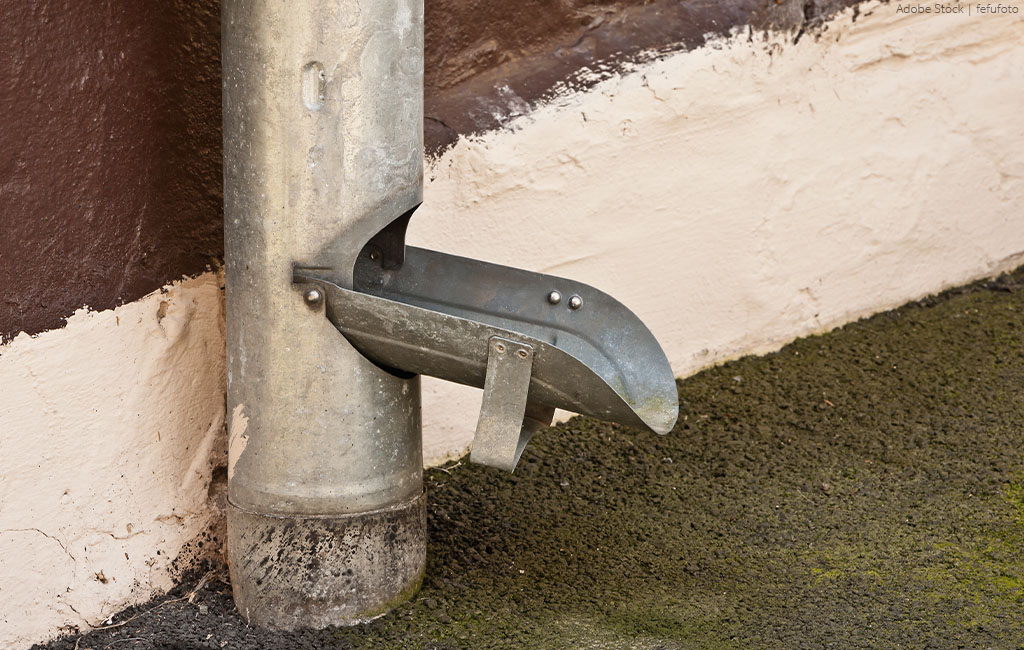
Suitable Equipment for Downspout Cleaning
Unlike gutters, downspouts are fully enclosed and inaccessible from the outside, making cleaning more challenging. Debris and blockages often can’t be easily removed and usually need to be cleared from the inside. If you have a standpipe with a cleaning flap near the ground, this can be particularly useful, allowing you to avoid disassembling parts of the downspout. In this case, a high pressure cleaner with a specialised pipe cleaning hose is ideal. The pipe cleaning hose is inserted through the cleaning opening into the downspout and guided upwards, using targeted high pressure to dislodge dirt and blockages within. This enables water to flow freely once again. After cleaning, it’s advisable to test the downspout by carefully letting water run through to ensure it’s functioning optimally and all deposits have been cleared.

Preventing Gutter Dirt and Blockages
Regular gutter cleaning is essential to prevent damage to your home. With the right tools—such as a leaf blower with an extension or a pressure washer—you can handle the job quickly and safely from the ground, even for quick interim cleanings. Installing gutter guards can also reduce heavy leaf buildup, keeping large debris out and preventing accumulation. This is especially useful if tall trees surround your home.
Our tip: It is better to check your gutter one time too many than too few. This way, water drainage is always secure, and you can avoid unnecessary problems.












